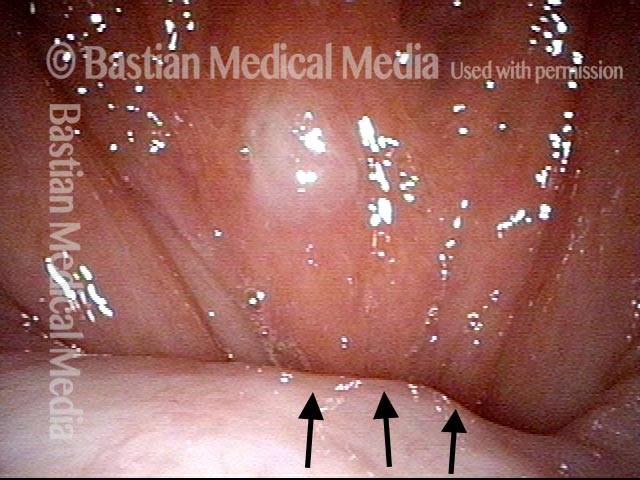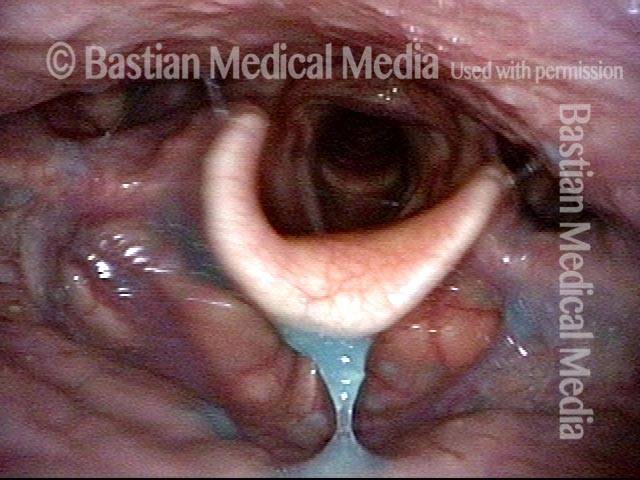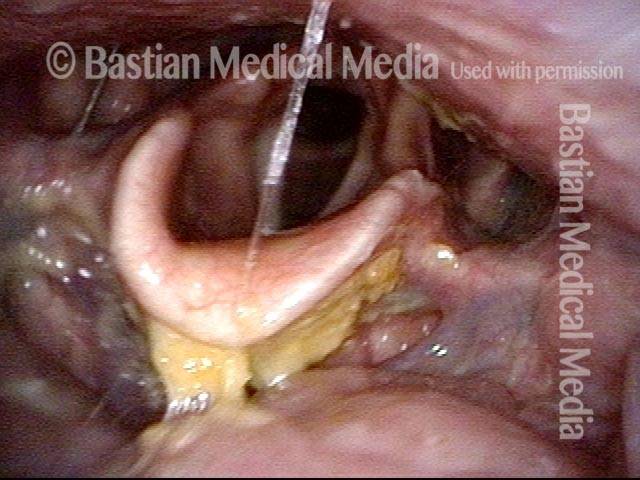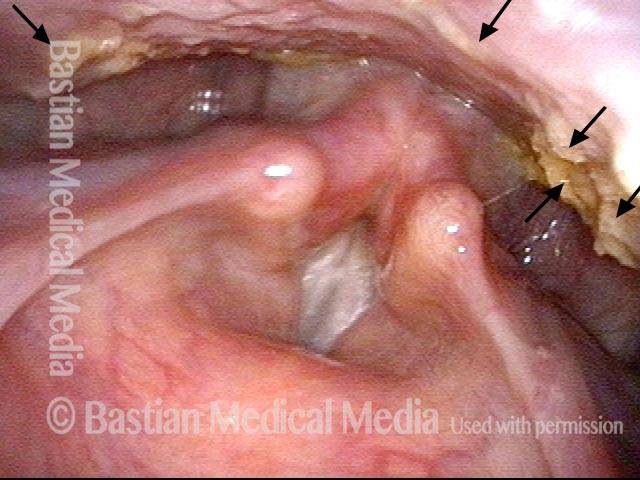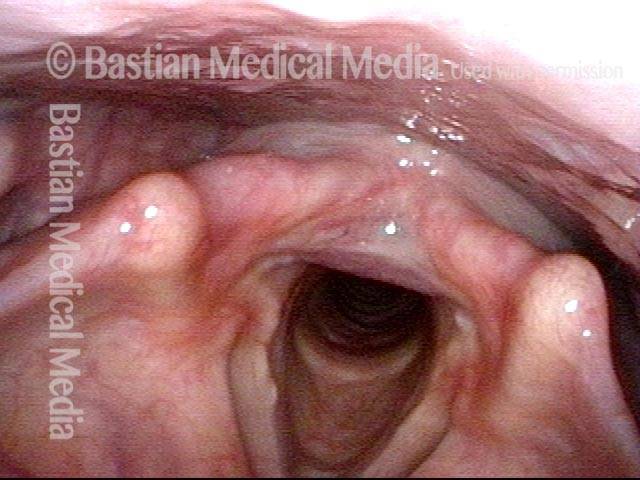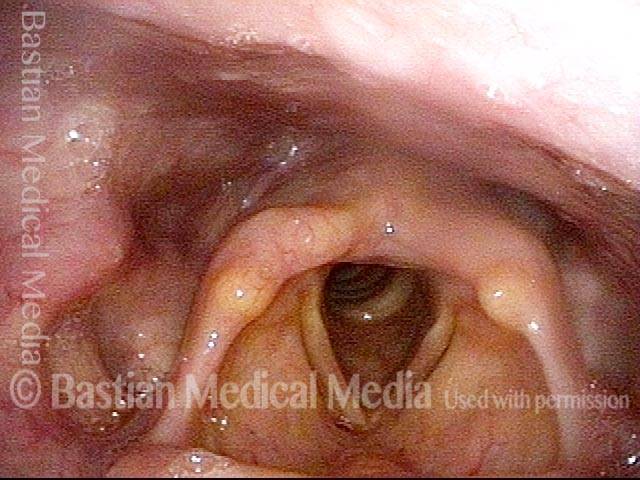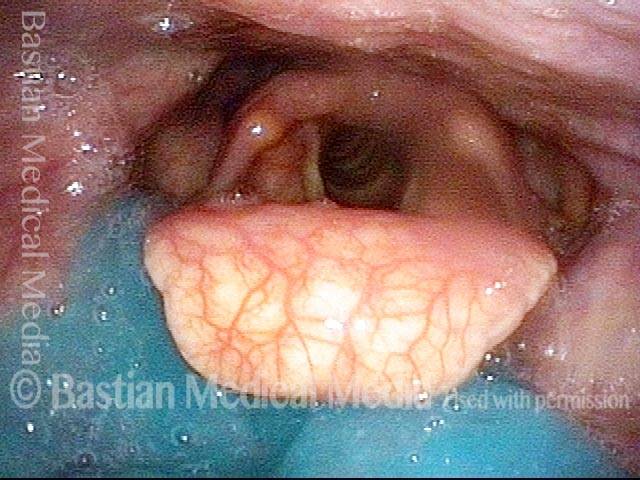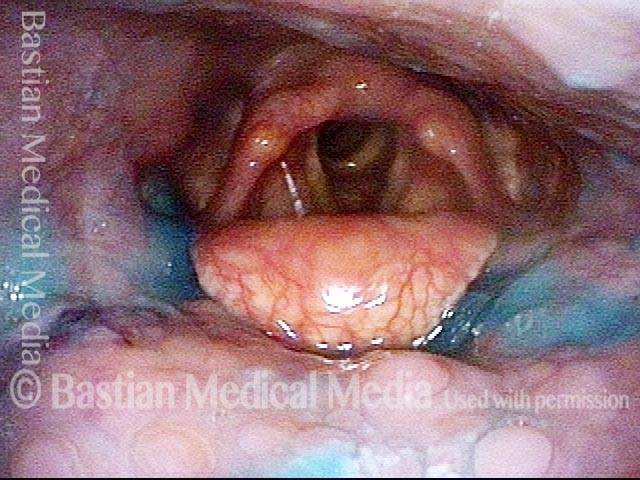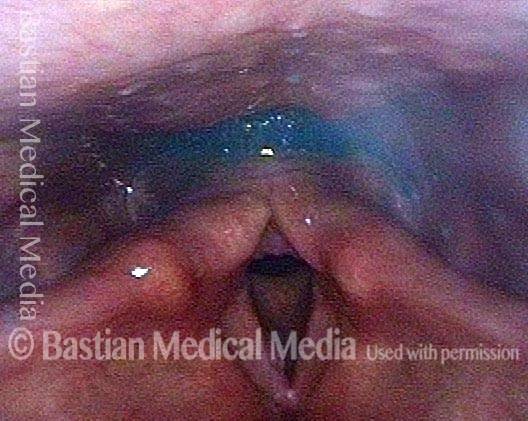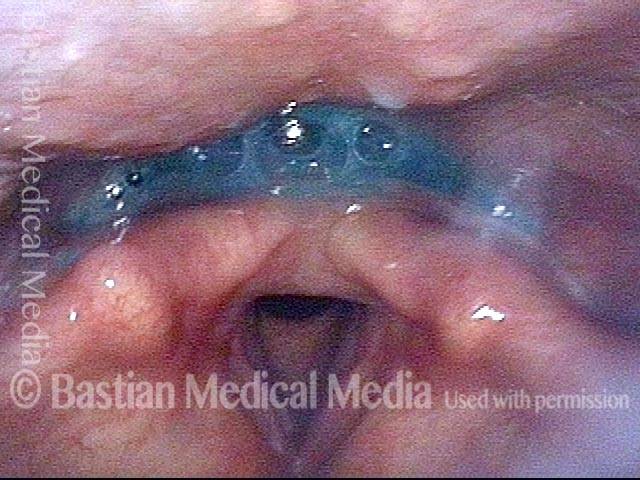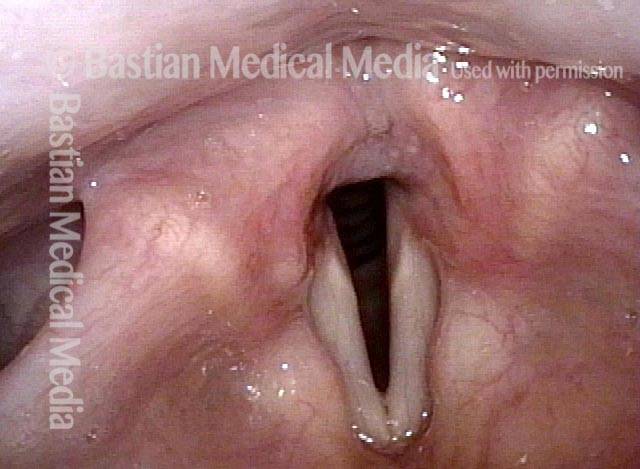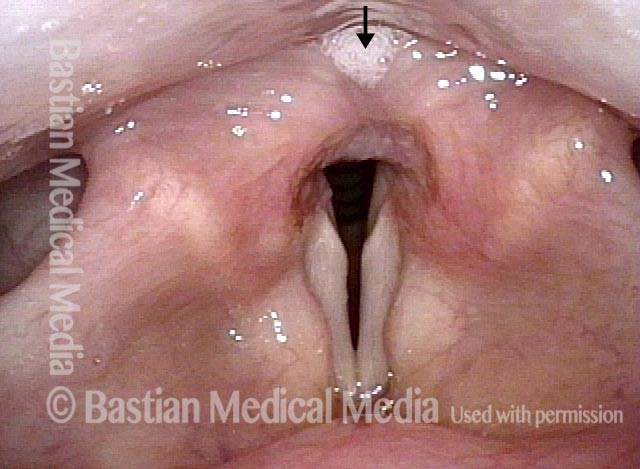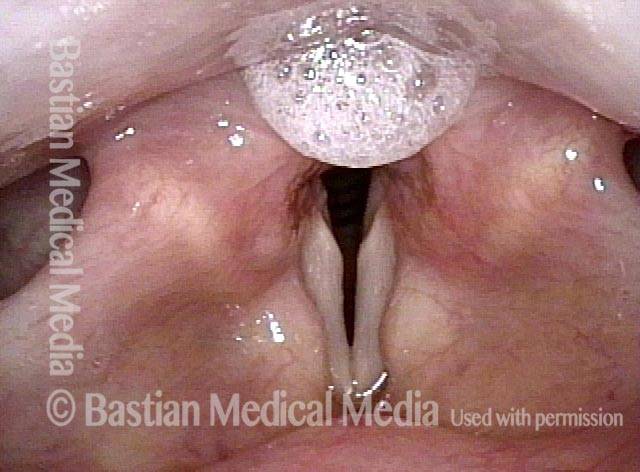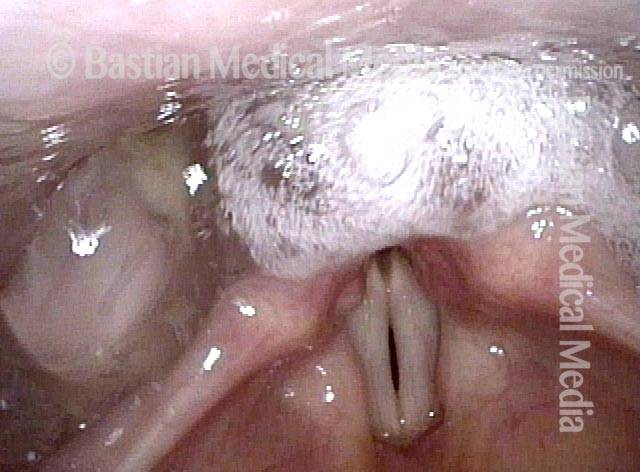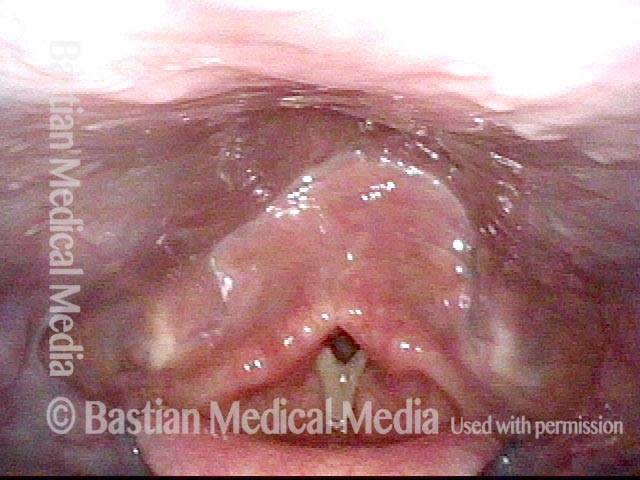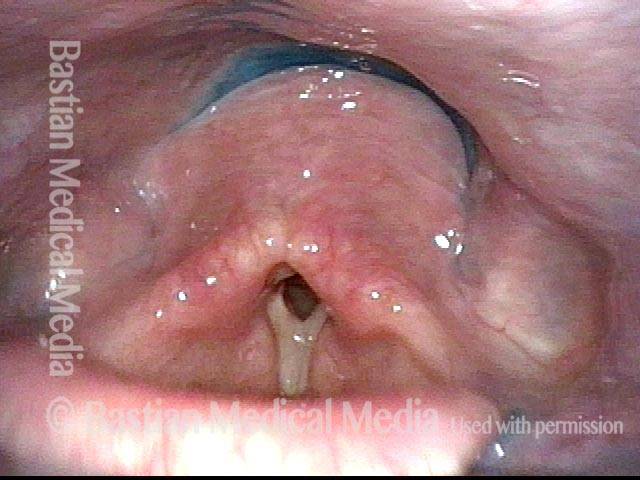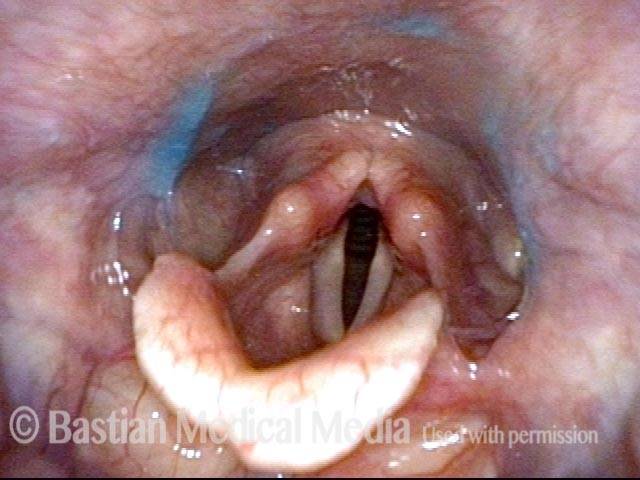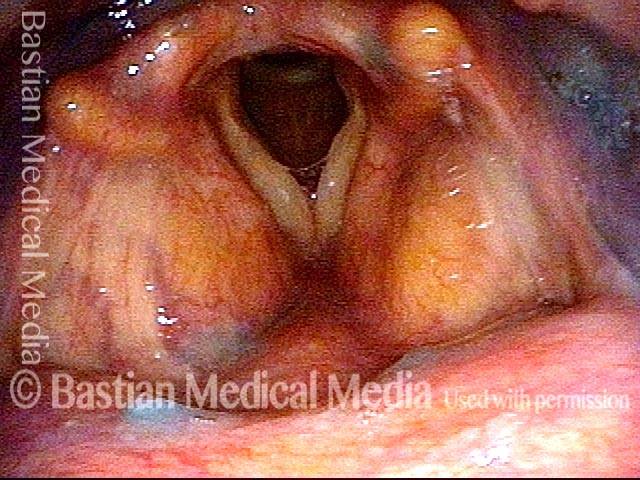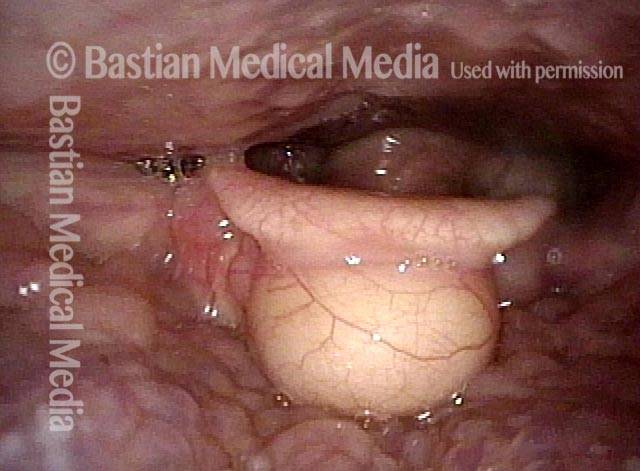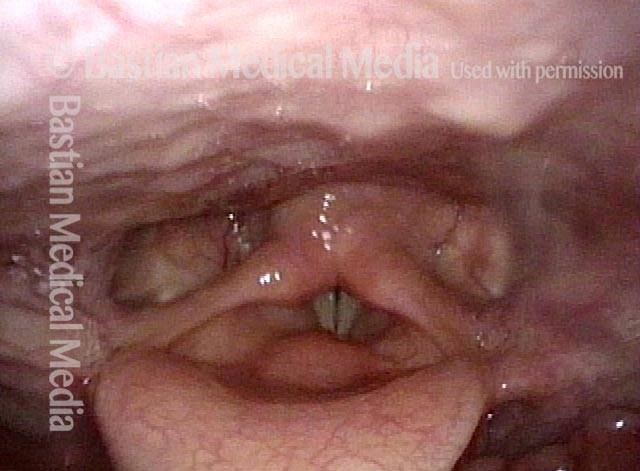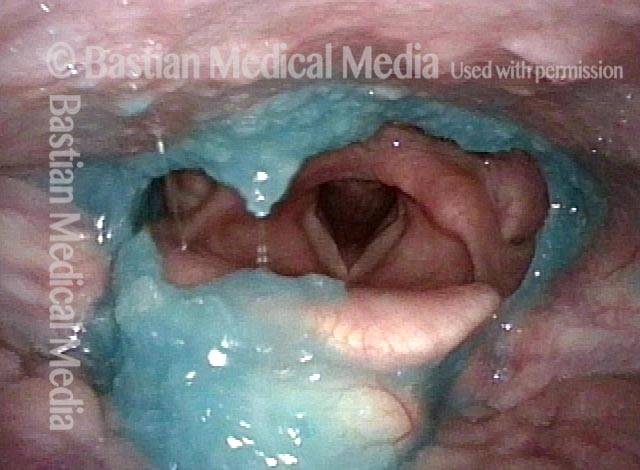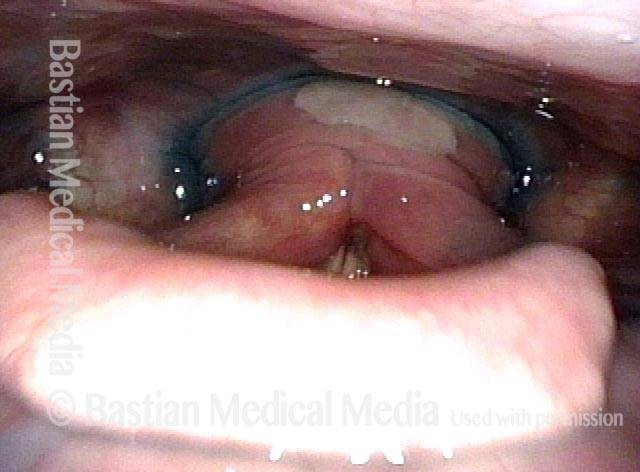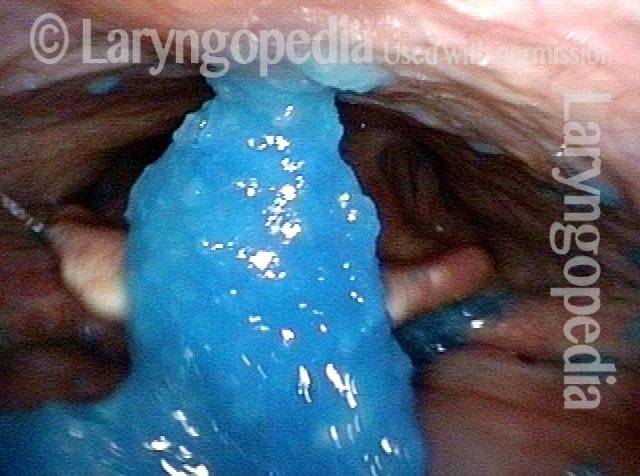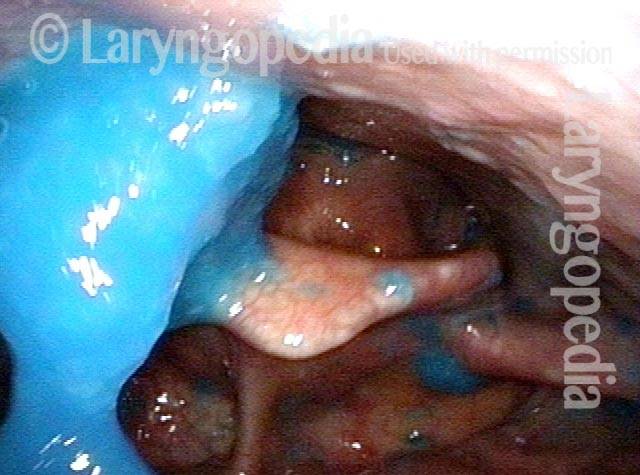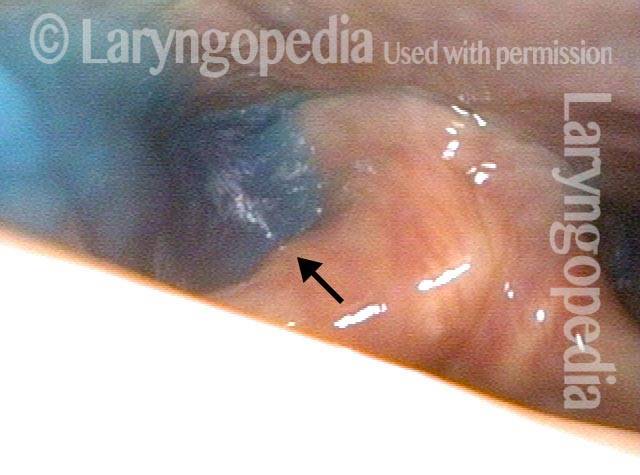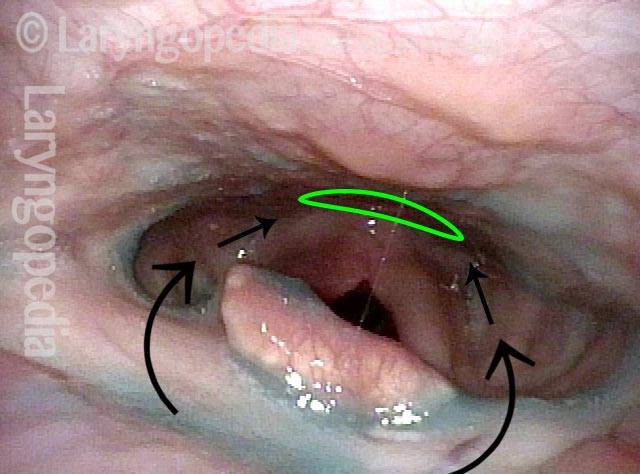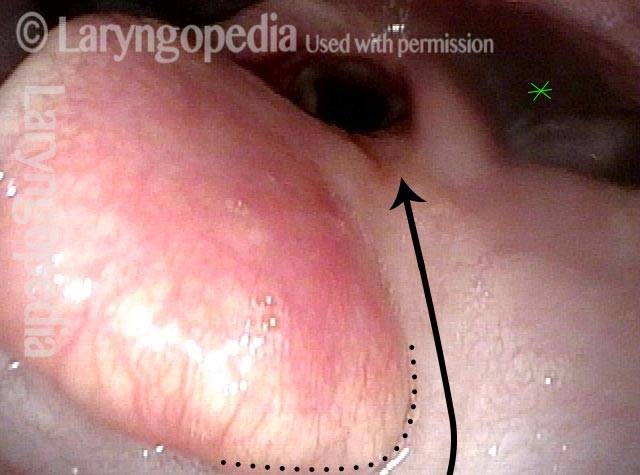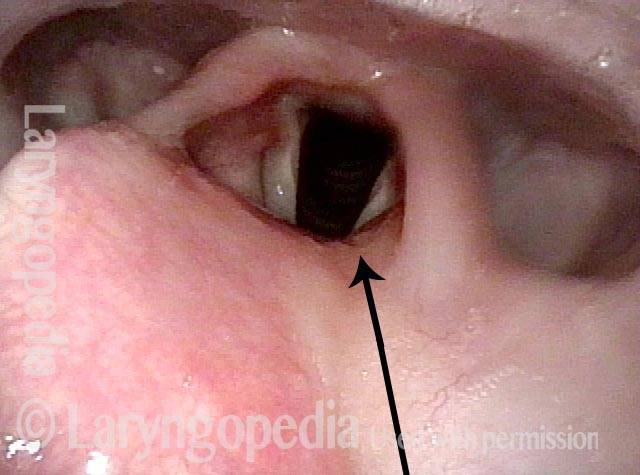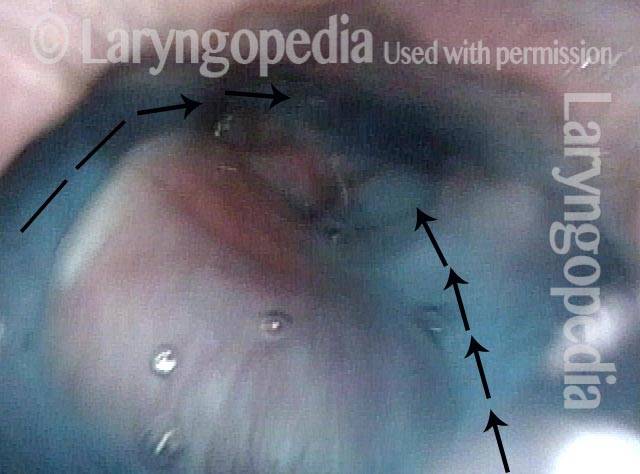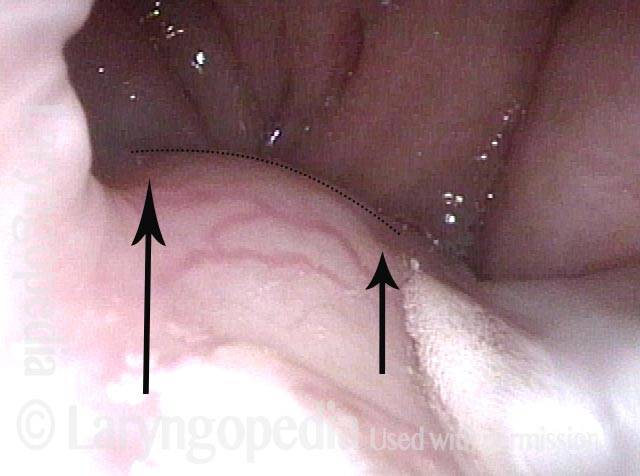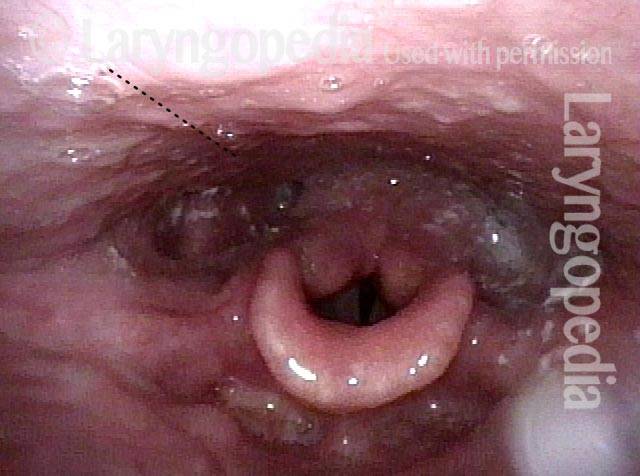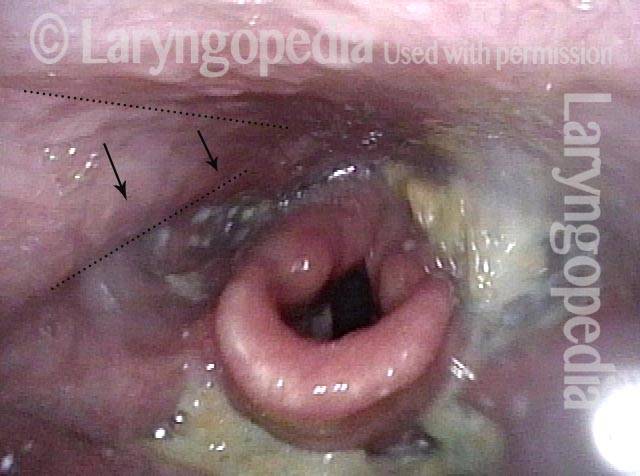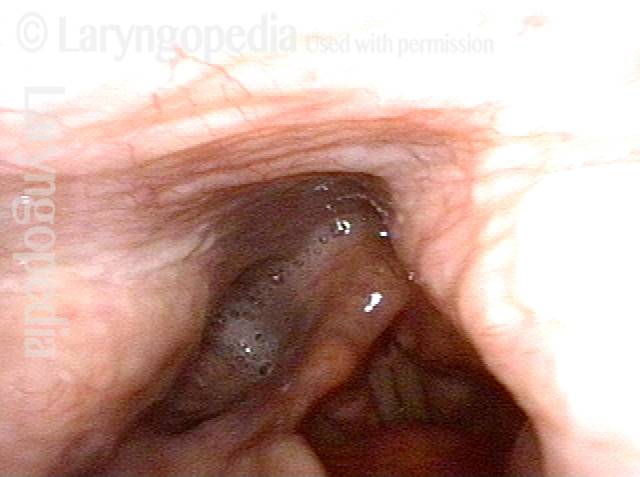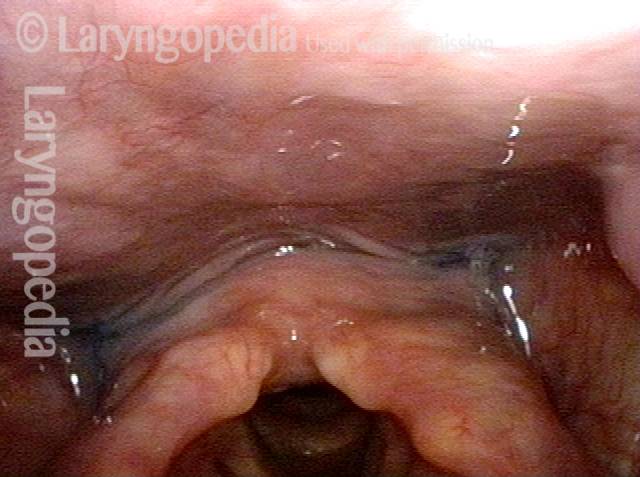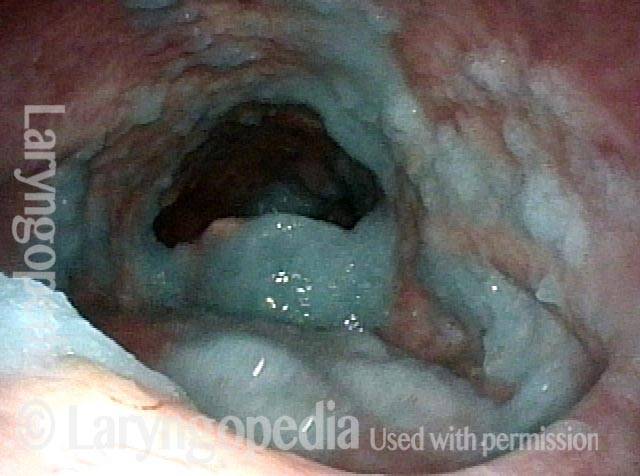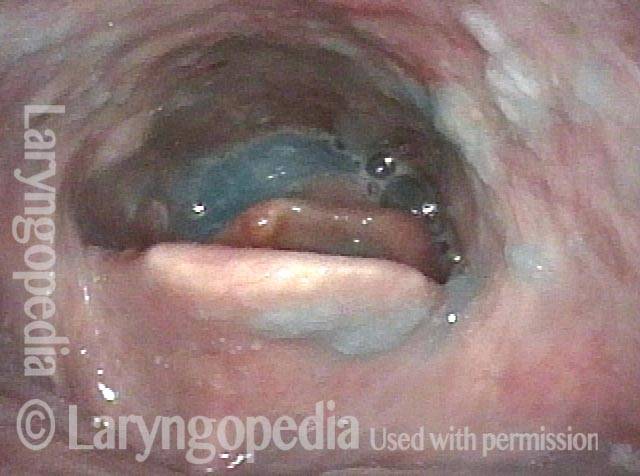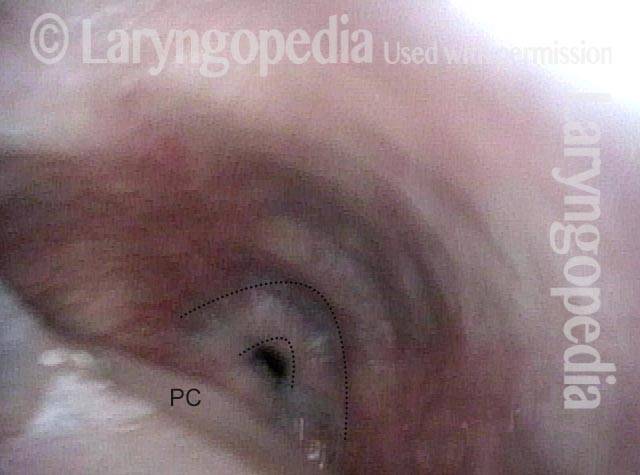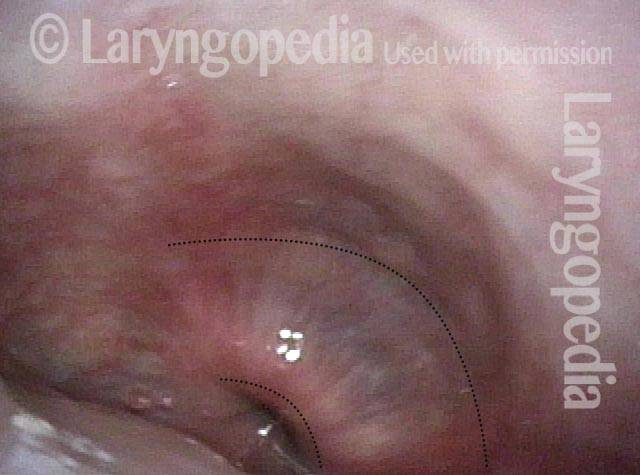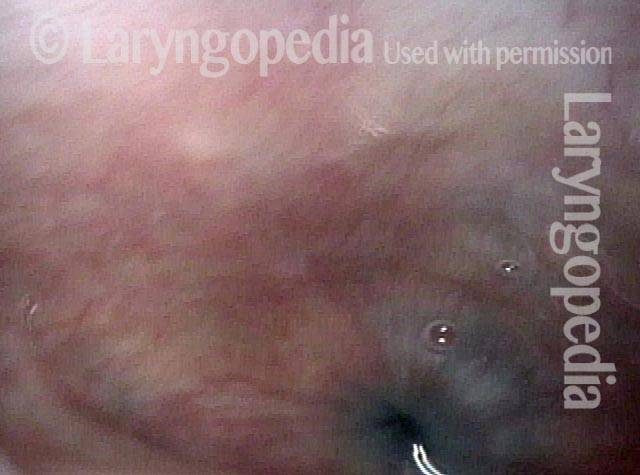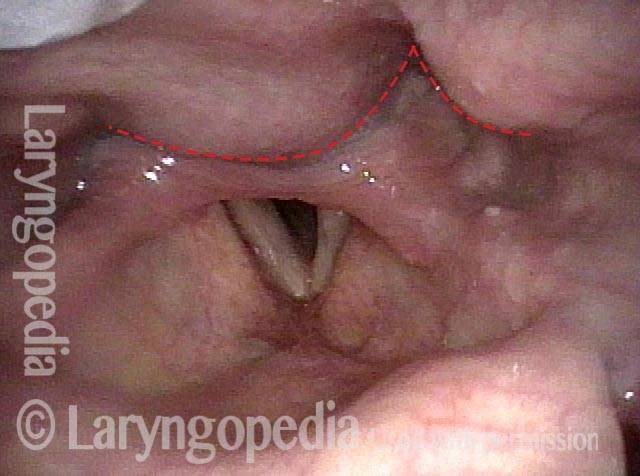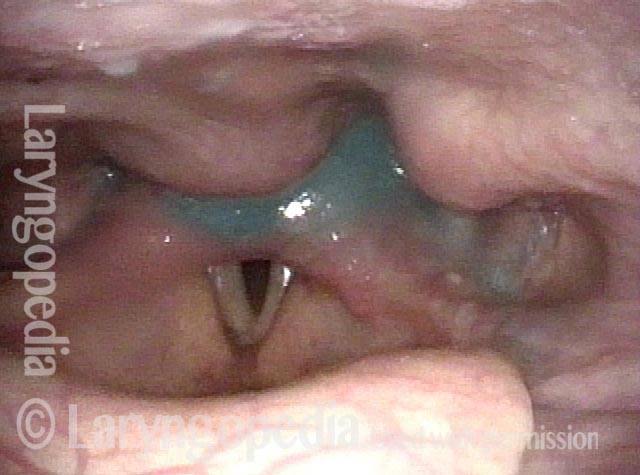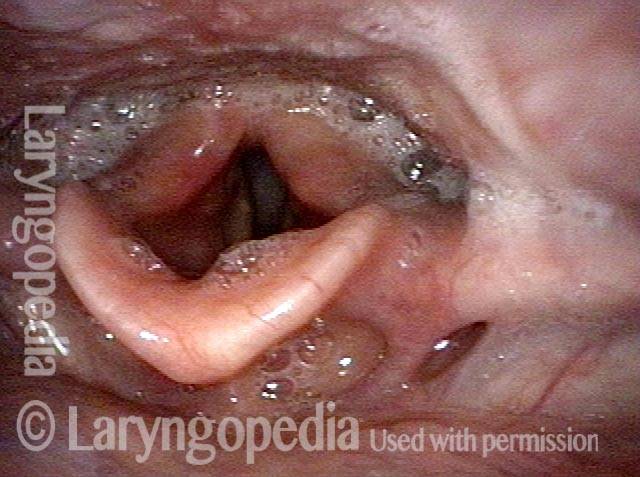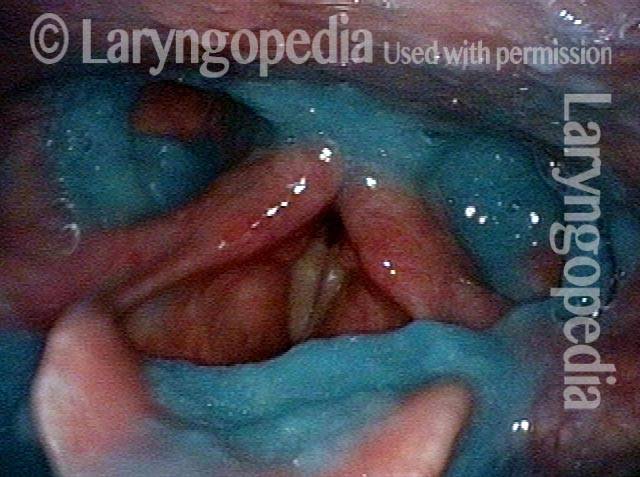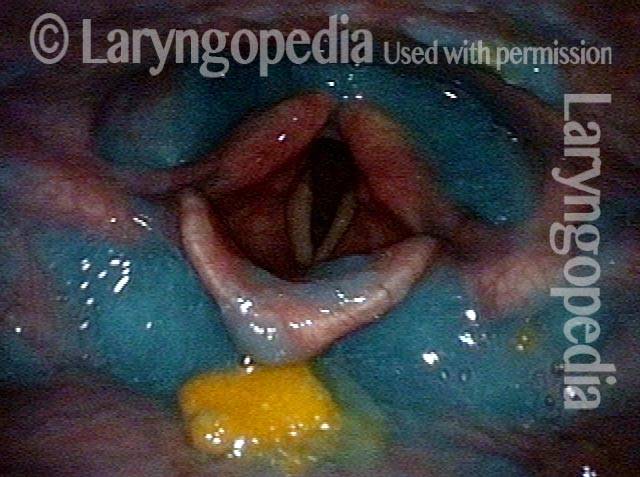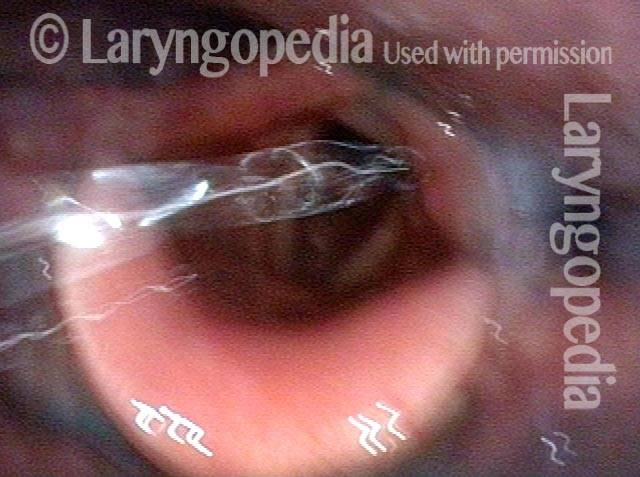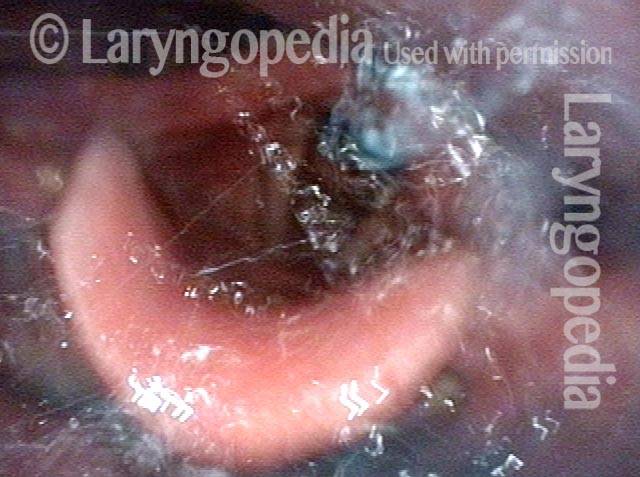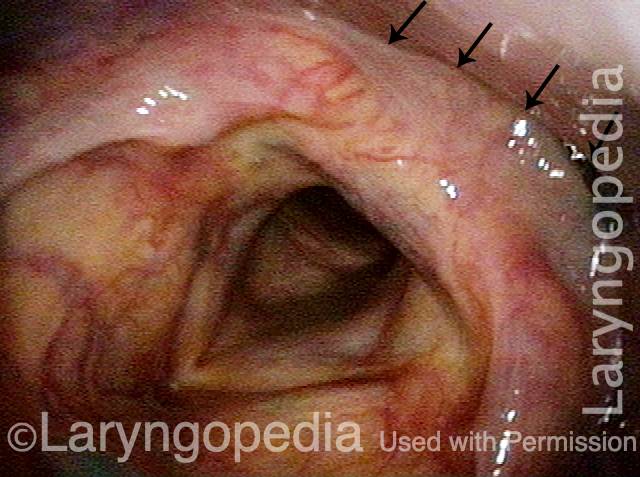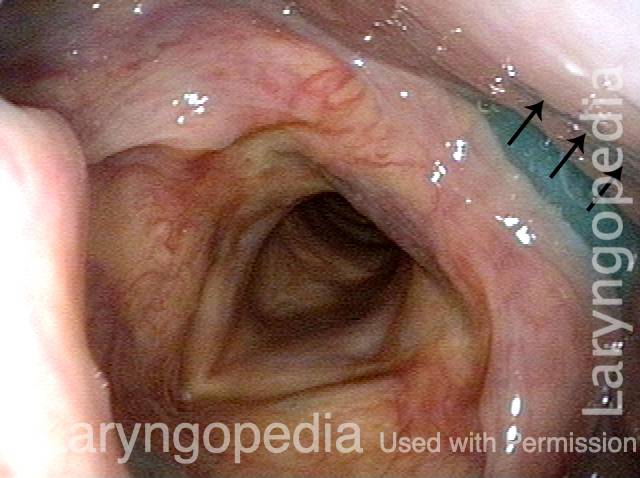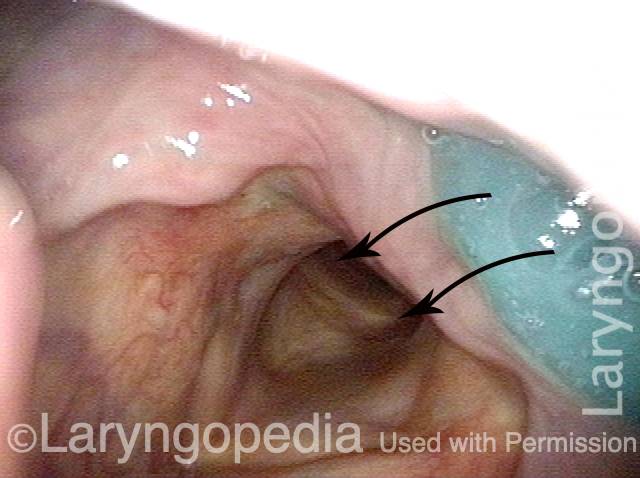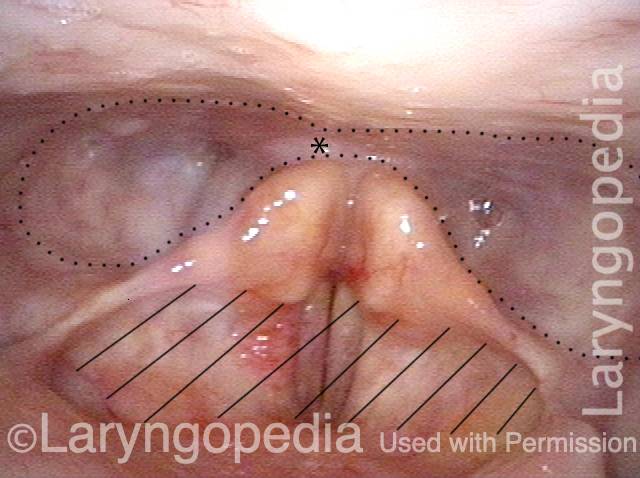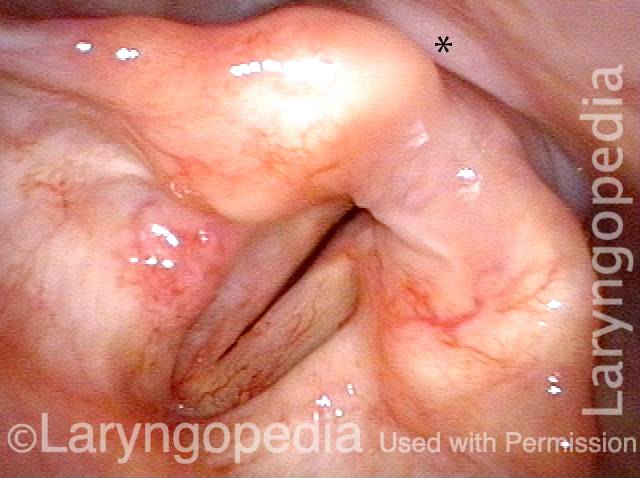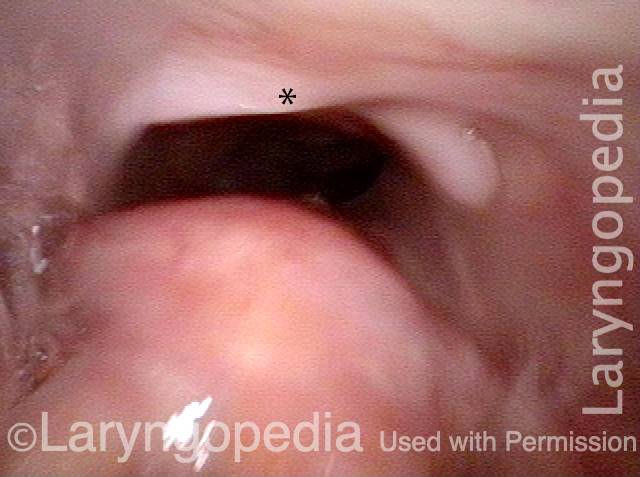Videoendoskopische Schluckstudie (VESS)
Eine Methode zur Bewertung der Schluckfähigkeit einer Person durch eine videodokumentierte körperliche Untersuchung, bei der aus dem Racheninneren geschaut wird. Wird auch als faseroptische endoskopische Bewertung des Schluckens (FEES) bezeichnet. Die videoendoskopische Schluckstudie (VESS) ist von der videofluoroskopischen Schluckstudie (VFSS) zu unterscheiden, bei der es sich um eine röntgenbasierte Untersuchung handelt.

Wie es funktioniert
Um ein VESS durchzuführen, verwendet ein Kliniker ein Fiberoptik- oder Distal-Chip-Nasolaryngoskop. Der Arzt beginnt mit der Untersuchung der Struktur und Funktion des Gaumens, der Zunge, des Rachens und des Kehlkopfes des Patienten, einschließlich der Empfindung, falls gewünscht. Um die Schluckfähigkeit und -einschränkungen des Patienten zu beurteilen, positioniert der Kliniker als Nächstes die Spitze des Nasolaryngoskops direkt unter dem Nasopharynx und bittet den Patienten, mit Blick nach unten in den Rachen, eine Reihe farbiger Substanzen mit unterschiedlichen Konsistenzen (z -beflecktes Wasser, blaubeflecktes Apfelmus und orangefarbene Cracker).
Während der Patient diese Substanzen schluckt, beobachtet der Kliniker, ob signifikante Spuren im Raum über, um oder innerhalb des Kehlkopfes verbleiben oder wieder auftauchen, anstatt im Eingang der Speiseröhre zu verschwinden. Wenn deutliche Spuren sichtbar bleiben oder Material in die Kehlkopföffnung oder die Luftröhre gelangt, kann der Patient Presbyphagie haben. Wenn signifikante Spuren zunächst verschwinden, dann aber vom Ösophaguseingang nach oben wieder auftauchen, kann der Patient eine krikopharyngeale Dysfunktion mit oder ohne Zenker-Divertikel haben.
Vorteile der videoendoskopischen Schluckstudie
Diese Methode ist besonders wertvoll für Patienten, die bettlägerig sind und nicht in die Radiologie gehen können, oder für Patienten, deren Schluckfunktion sich schnell entwickelt (normalerweise bessert), wie z. B. Patienten, die sich von einem leichten Schlaganfall erholen. Für Kliniker, die Erfahrung mit dieser Technik haben, kann VESS auch häufig bei neuen Patienten, die während der Erstkonsultation über Dysphagie klagen, als robuste und – je nach Anamnese – möglicherweise eigenständige Methode zur Diagnose und Behandlung eingesetzt werden.
Manchmal weisen die VESS-Befunde zusammen mit einer Patientenanamnese von Nahrungsaufnahme auf der Ebene des Krikoidknorpels oder des M. cricopharyngeus darauf hin, wann auch VFSS erhalten werden sollte, um eine mögliche krikopharyngeale Dysfunktion zu beurteilen. Selbst in diesem letzteren Fall, wenn VFSS aufgefordert wird, eine Verdachtsdiagnose zu bestätigen, hat VESS den Untersucher bereits über die Art und Schwere des Problems informiert. In den meisten Nachsorgesituationen außer nach krikopharyngealer Myotomie ist VESS im Allgemeinen effizienter und kostengünstiger als VFSS.


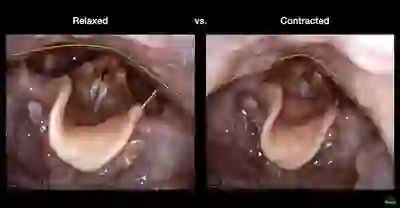
VESS (Videoendoskopische Schluckstudie)
Eine Methode zur Bewertung der Schluckfähigkeit einer Person durch eine videodokumentierte körperliche Untersuchung, bei der aus dem Racheninneren geschaut wird. Wird auch als faseroptische endoskopische Bewertung des Schluckens (FEES) bezeichnet.
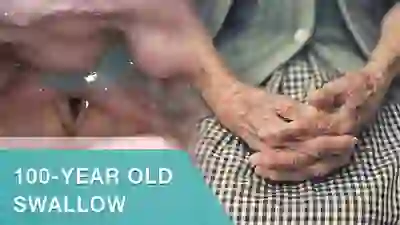
100 Jahre alte Schwalbe! SCHIFF
Die videoendoskopische Schluckstudie (VESS) ist eine Methode zur Bewertung der Schluckfähigkeit einer Person durch eine videodokumentierte körperliche Untersuchung mit Blick in den Rachen. Dieses Video zeigt ein Beispiel eines 100-jährigen Patienten, der sich einer VESS unterzieht.
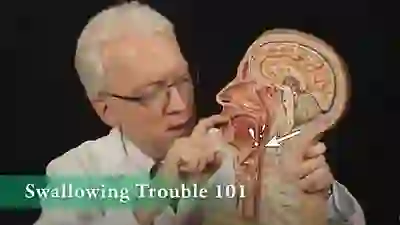
Schluckbeschwerden 101
Dieses Video gibt einen Überblick darüber, wie das Schlucken funktioniert, wie es manchmal schief gehen kann und wie diese Probleme behandelt werden können.
VESS bewertet Ausrüstung, Sekrete und dann die Schluckfähigkeit
Part Ia: Palate elevates normally (1 of 7)
Part Ia: Palate elevates normally (1 of 7)
Part Ib: phonation (2 of 7)
Part Ib: phonation (2 of 7)
Part Ic: High pitch elicited (3 of 7)
Part Ic: High pitch elicited (3 of 7)
Part IIa: applesauce (4 of 7)
Part IIa: applesauce (4 of 7)
Part IIb: cracker (5 of 7)
Part IIb: cracker (5 of 7)
Part IIb: continued (6 of 7)
Part IIb: continued (6 of 7)
Part IIc: water (7 of 7)
Part IIc: water (7 of 7)
Dysphagie / verzögerter Schluckreflex
Laryngopharynx (1 of 3)
Laryngopharynx (1 of 3)
Dysphagia / Delayed swallow reflex (2 of 3)
Dysphagia / Delayed swallow reflex (2 of 3)
Hypopharyngeal pooling (3 of 3)
Hypopharyngeal pooling (3 of 3)
Zenkers Divertikel
Zenker’s diverticulum (1 of 3)
Zenker’s diverticulum (1 of 3)
Postcricoid area (2 of 3)
Postcricoid area (2 of 3)
Hypopharynx (3 of 3)
Hypopharynx (3 of 3)
Beispiel 2
Zenker’s diverticulum (1 of 4)
Zenker’s diverticulum (1 of 4)
Saliva from Zenker’s sac (2 of 4)
Saliva from Zenker’s sac (2 of 4)
More saliva (3 of 4)
More saliva (3 of 4)
Forced to re-swallow (4 of 4)
Forced to re-swallow (4 of 4)
Reflux in den Hypopharynx, charakteristisch für krikopharyngeale Dysfunktion
Reflux into hypopharynx (1 of 3)
Reflux into hypopharynx (1 of 3)
Water flows into the swallowing crescent (2 of 3)
Water flows into the swallowing crescent (2 of 3)
Larynx opens up (3 of 3)
Larynx opens up (3 of 3)
Hypopharynx-Pooling nach dem Schlucken
Hypopharynx pooling after swallow (1 of 1)
Hypopharynx pooling after swallow (1 of 1)
Kehlkopfpenetration
Laryngeal penetration (1 of 1)
Laryngeal penetration (1 of 1)
Vallekulare Zysten stören das Schlucken nicht – außer wenn sie es tun
Vallecular cyst (1 of 4)
Vallecular cyst (1 of 4)
Evaluation of function (2 of 4)
Evaluation of function (2 of 4)
Applesauce residue (3 of 4)
Applesauce residue (3 of 4)
Water wash (4 of 4)
Water wash (4 of 4)
Pillenunterbringung aufgrund von Schluckbehinderung
Lodged pill (1 of 4)
Lodged pill (1 of 4)
Trumpet maneuver (2 of 4)
Trumpet maneuver (2 of 4)
VESS (3 of 4)
VESS (3 of 4)
Incomplete relaxation of CPD (4 of 4)
Incomplete relaxation of CPD (4 of 4)
Verzögerter Schluckreflex: Vergleichen Sie blaues Apfelmus und blaues Wasser
VESS (1 of 4)
VESS (1 of 4)
Delayed swallow reflex (2 of 4)
Delayed swallow reflex (2 of 4)
Blue-stained water (3 of 4)
Blue-stained water (3 of 4)
No residue (4 of 4)
No residue (4 of 4)
Narbenbildung leitet geschluckte Materialien direkt in den Kehlkopf
Post tonsillectomy (1 of 4)
Post tonsillectomy (1 of 4)
Closer view (2 of 4)
Closer view (2 of 4)
The „chute“ (3 of 4)
The „chute“ (3 of 4)
Abnormal diversion (4 of 4)
Abnormal diversion (4 of 4)
Schädelbasisfraktur und Verletzung des Vagusnervs – Beachten Sie die Pharynxkontraktion und die Auswirkungen auf das Schlucken
Palate branch of the vagus nerve (1 of 4)
Palate branch of the vagus nerve (1 of 4)
Pharynx branch of the vagus nerve (2 of 4)
Pharynx branch of the vagus nerve (2 of 4)
Damage to left vagal nerve function (3 of 4)
Damage to left vagal nerve function (3 of 4)
Residue during swallowing test (4 of 4)
Residue during swallowing test (4 of 4)
VESS in 6 Standbildern
Assessing the patient’s swallowing (1 of 6)
Assessing the patient’s swallowing (1 of 6)
Observing the pharynx (2 of 6)
Observing the pharynx (2 of 6)
Patient secretions (3 of 6)
Patient secretions (3 of 6)
Pooling of swallowed pureed food (4 of 6)
Pooling of swallowed pureed food (4 of 6)
Swallowing solids (5 of 6)
Swallowing solids (5 of 6)
Residue after foods (6 of 6)
Residue after foods (6 of 6)
VESS (Videoendoskopische Schwalbenstudie) Befunde nach Strahlentherapie
Narrowed pharyngeal wall (1 of 7)
Narrowed pharyngeal wall (1 of 7)
Swallowing applesauce (2 of 7)
Swallowing applesauce (2 of 7)
After sipping water (3 of 7)
After sipping water (3 of 7)
Gravity aiding in swallowing (4 of 7)
Gravity aiding in swallowing (4 of 7)
Lifting larynx (5 of 7)
Lifting larynx (5 of 7)
A closer look (6 of 7)
A closer look (6 of 7)
Gravity aiding again in swallowing (7 of 7)
Gravity aiding again in swallowing (7 of 7)
Zervikale Osteophyten selbst scheinen kein großes Hindernis beim Schlucken zu sein
Protruding osteophytes (1 of 2)
Protruding osteophytes (1 of 2)
Rapid swallowing (2 of 2)
Rapid swallowing (2 of 2)
Aspiration und Quelle des zurückgekehrten Aspirats nach Husten
Salivary pooling (1 of 5)
Salivary pooling (1 of 5)
After applesauce (2 of 5)
After applesauce (2 of 5)
After cheese cracker (3 of 5)
After cheese cracker (3 of 5)
After water (4 of 5)
After water (4 of 5)
Cough expels the water from airway (5 of 5)
Cough expels the water from airway (5 of 5)
Das Zenker-Divertikel gibt seinen Inhalt nach jedem Schlucken nach oben in die Kehle zurück
VESS (1 of 3)
VESS (1 of 3)
Swallowing Crescent (2 of 3)
Swallowing Crescent (2 of 3)
Applesauce spills into airway (3 of 3)
Applesauce spills into airway (3 of 3)
Drei Ansichten des Ösophaguseingangs von weit weg bis nah
Swallowing Crescent (1 of 3)
Swallowing Crescent (1 of 3)
Closed esophagus (2 of 3)
Closed esophagus (2 of 3)
Open Esophagus (3 of 3)
Open Esophagus (3 of 3)
Teile diese Seite!
